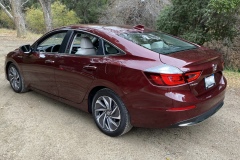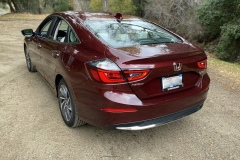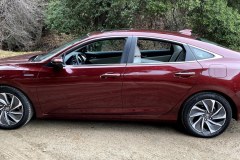The Phoenix–the Junk Yard Dog That Took Home the Record
Eric Lundgren, creator of the concept called Hybrid Recycling and Founder of IT Asset Partners, was out to take his junkyard dog BMW electric car with 90 percent recycled parts and make a run for a Guinness Record. Built at a cost of $13,800 in 45 days with no R&D and three-year-old batteries repackaged from broken cells, “The Phoenix” was going to challenge the current record for the furthest distance driven by an electric car on a single charge. The record was held by a very professional Japanese effort that set the benchmark at 800 miles, driving on a very level track.

Eric talked with us about The Phoenix: “The controller came out of a forklift. The charger came out a very old DC electric vehicle. The compressor for the power brakes came out of an old air conditioner. The pump came out of a fish tank. The whole thing is made out of trash – the car itself was dragged out of a junkyard.”
All up The Phoenix weighs 4,200 pounds with the 200-kilowatt-hour battery pack. Eric’s plan was to take The Phoenix and run it for as close to 48 hours as possible on the less than level Auto Club Speedway in Fontana, CA.
Intriguing! What could it hurt to attend this Guinness Book attempt? Spirit Airlines could hurt, their logo should be in the dictionary next to the word “incompetent.” We landed three hours late and missed meeting some really interesting people. To get to the track we borrowed a mobile cocoon from Toyota called the Prius Prime. The Prime proved to be the perfect tool for heavy LA traffic. Flicking on the adaptive cruise control to cope with football signal velocity drift and stop–0/25/75/40/0 (MPH) hike–or maybe drive; hey, it’s LA. We were driving the current most advanced (practical) vehicle drivetrain to get to observe what is expected to be the future’s most advanced (practical) vehicle drivetrain. Bonus points–56 MPG! It was nice that the Prius Prime relieved some of the angst of driving in from LAX.
Finally at the Track
When we finally pulled in at 9:15 p.m., we found Eric Lundgren running on adrenaline. At that point he had already been up for close to 48 hours. Eric told us that the sweet spot for a maximum distance was 28 mph, where there would be little aerodynamic drag. His plan was to go to 30-to-35 mph for a hoped-for 1,200 miles. (He anticipated he could achieve 1,000 miles.) In this configuration The Phoenix had already demonstrated a 740 mile range–on the highway!

From the drive, Spencer (no last name): “We have to limit our speed. We need to keep the whole journey under 50 amps. I didn’t think that we could ever do 39 amps at 50 mph. Earlier in the day we were not getting that kind of efficiency. Heat of the day, efficiency, mid-range of the battery. Every battery chemistry has its own profile for how it pulls amperage. This battery may be better in the mid-range.”
Eric and half of his crew appeared to be exhausted, but dedicated and totally absorbed in their efforts.
Eric at 10 p.m.: “Yesterday, when we turned this car on, wouldn’t you know that all of the calibrated settings were wiped. We connected the controller and one guy went ‘oops,’ and reset all the settings. To my AC motor. To my cruise control. I had to redo the regeneration. I had to redo all the settings. It took the entire night.”
The Phoenix had a set-back that cost eight of 48 hours available at Fontana–ouch.
The amperage readings soared as The Phoenix passed the start/finish line and began the mild uphill climb.
Finding the Right Gear
Eric, a little while later: “If you’re driving in fourth gear and you floor it, then you are just dumping energy and not getting anything out of it. We put in a cruise control and we can do a perfectly calibrated cruise setting but the entire track is slanted. We are going up a hill, down a hill, up a hill, down a hill, so we can’t do cruise control here. Two-thirds of the course I can put it in fourth and one-third I have to be in third gear. Some drivers are good and can feel when it is lugging. We figured out a median by voltage.

We have gone 256 miles and we have used roughly 16 percent of our pack. You can do the math, but we had to increase the speed because we don’t have enough time on the track. If we had a flat track, at 28 mph we might be able to hit 1,580 miles, but let’s be honest, we have to beat 808 miles. We are going to smash that.”
Sam Rosner was conducting a video interview and asked: “So, then, this is going to be way more realistic?” Eric responded that: “We are not robbing Peter to pay Paul. We have to treat the pedal like there’s an egg under your right foot. But yes, this is going to be close to the real world in terms of what we can achieve.”
Things went smoothly until 10:30 p.m., then the car was slowing. The red safety truck flew out, going counter-clockwise to intercept the BMW. The Tesla support vehicle soon followed. The battery controller was hitting BBQ temperatures. Don from the crew told me later that the windshield fluid chamber used for cooling was bubbling hot. “We added some really cold water and turned the pump back on and it worked.” The Phoenix was rolling again. Tension dropped as the BMW quietly slipped past. Phil was calculating numbers; it looked like he had lots of spare power, but it was nighttime and in the cool air the batteries were fairing better. The Guinness Book witnesses changed shifts at 10:45 p.m., when Spencer took the wheel. Sam volunteered to take over the walkie-talkie, coaching the driver like Eric and doing spot calculations, so that Eric could take a nap.
Time To Play
The cat was away and Spencer wanted to play. Instead of dropping to third, Spencer wanted to see if he could dial in the controls and keep the car rolling in fourth. At 28 mph, point up hill, drop to third and the readout stated 126.3 volts; 36 mph took 53 amps; Phil said “bring it up to 60 amps. See if you can keep 32 mph going up the hill. Twenty-eight mph sucks; it feels like you are dying. It’s like a guy on roller skates pushing a piano up a hill.”
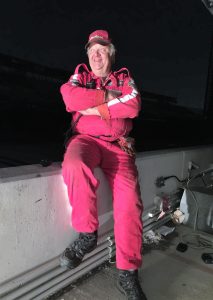
Spencer was getting pretty smooth and we were joking around in pits and talking about the Back to the Future DeLorean going 88 mph.
Max Balchowsky and his cobbled together championship Old Yeller cars kept popping into my head. Max used to get a kick out of going through the trash of the mighty Ferraris and Jaguars, pulling out an old spark plug (or a suspension) and asking if he could have it for his car. Max would regularly drive up to the Laguna Seca track with his four racing tires strapped together, tied into passenger seat. Quite often the winner’s trophy would be belted to the top of the tire pile for the ride home.
Into the Night/A Revelation
Brother Carl Lundgren from Ohio took the walkie-talkie and called The Phoenix in to change the card for the onboard camera. Derek took the wheel at 12:15 a.m., going out with a fully charged walkie-talkie. Sam went back on communications. Spencer’s idea of dialing in the potentiometer to control power appealed to Derek and Carl. They decided to go with it. The cold air meant that the car was using a bit less power–121.4 volts was the reading. The Phoenix started at 134 volts and 80 volts meant dead stop. The Phoenix might be able to hit 1,000 miles. At 1:45 a.m. Eric and Carl’s mom came over and examined the numbers like a forensic accountant. Derek was turning laps of 3 minutes: 22 seconds; 3.21, 3.22– very consistent numbers. There were 30 hours left on the clock; things were looking pretty good. Carl asked
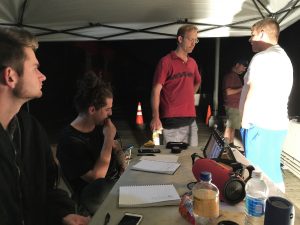
“Which is the enemy–time or power? We might have enough power for 32 hours, but we have 29.” Meanwhile the Guinness witnesses were asked if they could sign up for a few extra hours.
At 3:53 a.m. the reading was at 118.2 volts remaining, with 454 laps covered. It looked like The Phoenix was chewing up about one volt per hour. Phil emerged from his nap sporting clean clothes and a big smile. Sam and Carl explained what Spencer had come up with after Phil left for his nap. Phil, an ex-Navy electronics wizard, did not like Spencer’s idea, but when he ran his numbers and figured out that it was working, he said to go with it. At 4:37 a.m. The Phoenix hit 480 miles.
The Phoenix would beat its previous best of 750 miles, but it wouldn’t be until 11 a.m. that it cruised past the old record of 808 miles. Would it hit the half-ton? Almost. She came in at 999.5 miles.
The 12-volt system running the controller (which runs the motor) stopped functioning, causing a catastrophic failure. By Eric’s calculations, The Phoenix still had 110 miles in the battery pack.
The show was over, but the record had fallen, and it fell pretty hard.
The Art of the Possible
From Eric” “We want to show people what is possible, stop wasting their waste. We want to make lemons into lemonade. All of this trash that we throw away–that hurts us. Because we don’t know what to do with it, we dump it, and it leeches these chemicals into our environment, into our water table and we drink it.” Lithium-Ion, lithium-polymer, iron-phosphate are the new battery chemistries. The old one, lead acid–99.9 percent gets recycled, because it has been around forever, and we came up with all these solutions.” “But these new battery technologies are changing all the time so quickly.
More Eric: “So it’s very hard to find a solution to be able to recycle them for their commodity value. But it is easy to go from a utilitarian value. You can offset the actual recycling needed for the broken batteries. Salvage the good, (repackage it), and put it into a new application. That’s the secret–Hybrid Recycling.”

And more Eric: “We have done hundreds (of new applications.) We have done 18650 cells, the prismatic cells, the LG Chem cells, all going into e-wheelchairs. We worked with the company and we built electric wheelchairs that cost half as much and go twice as far (as current ones on the market), and are better for the environment. We take your cell phone and, when it breaks, we turn it into a video doorbell unit. We take your tablet and, when it breaks, we turn it into a flip-down unit for the back of your car for your kids to watch their cartoons.”
There are companies who have been unwilling to consider Hybrid Recycling, according to Eric. “They take the battery pack that has one broken part, where 90 or 100 pieces are working perfectly, generic components. They take it and they smelt it. Melt it for commodity value. Bringing all of its value down to its lowest use–tin and copper. They recycle the lithium, and say ‘aren’t we doing a great job?’ There is one car company that specifically refuses to use Hybrid Recycling. They sell their used batteries to a company that does not even recycle them–a middleman who gives it to a company located outside of BC (British Columbia, Canada) that takes the whole battery and they smelt it. It creates 18 percent toxic slurry that you cannot reuse. It (the slurry) floats up to top, comingled plastic and rubber and all the chemicals. They take off that 18 percent. You cannot dump that in Canada because it is so toxic. So they import it to my home state of Washington and dump it into an environmental landfill. Which is basically a hole with a giant plastic bag that you put stuff in and cap off. Mercury, lead, bromine, cadmium. Because we don’t know how to recycle this stuff properly.”
The electronic waste stream in the US is growing by leaps and bounds. Eric’s company ITAP grew up taking old computer equipment and digital trash and repurposing it rather than seeing it go to the dump or melted into toxins. An old BMW with parts pulled from a forklift as well as an assortment of other equipment lying around took on on some of the best the world could offer and won. It’s just using your brains, Hybrid Recycling.
Somewhere out there one of the great American Icons of car racing, Max Balchowsky, must be sporting an ear-to-ear grin, another American junkyard dog has notched up another win.
Here’s a video interview with Eric Lundgren by Sam Rosner.

